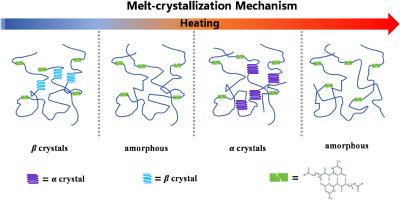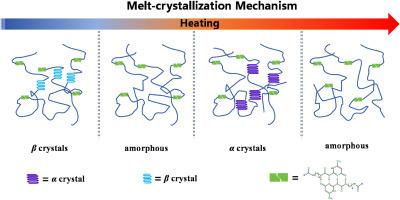Inter-end-group hydrogen bonding modulates crystallization and polymorphic transition of poly(butylene adipate)
IF 4.5
2区 化学
Q2 POLYMER SCIENCE
引用次数: 0
Abstract
Telechelic poly(butylene adipate) (PBA) bearing terminal 2-ureido-4[1H]-pyrimidinone (UPy) moieties was synthesized to investigate hydrogen bond-mediated melt crystallization and crystal transition behavior. Differential scanning calorimetry and wide-angle X-ray diffraction revealed that quadruple hydrogen-bonding interactions among UPy moieties significantly suppressed the overall crystallinity and altered polymorphic selectivity. Compared to hydroxyl-terminated PBA (HPBA), UPy-terminated PBA (UPBA) exhibited an expanded temperature window for forming the thermodynamically stable α-crystal and a broader α/β crystals coexistence region during isothermal crystallization, indicating retarded β-crystal growth kinetic advantage. UPy end groups enhanced the melt memory effect by stabilizing mesomorphic structure, widening the self-nucleation domain (Domain IIa). In situ temperature-resolved Fourier transform infrared spectroscopy investigation demonstrated that the hydrogen-bonding interactions among terminal UPy moieties are sensitive to the melting and crystallization process of PBA. Critically, the slow increase in UPy hydrogen-bonding intensity coinciding with β-crystal melting, followed by a sharp decrease during α-crystal formation, provided direct evidence that the β to α crystal transition in UPBA predominantly follows a melt-recrystallization mechanism rather than a solid-solid transformation.


端基间氢键调节聚己二酸丁烯的结晶和多态转变
合成了端部含2-脲基-4[1H]-嘧啶酮(UPy)的远旋聚己二酸丁二烯(PBA),研究了氢键介导的熔融结晶和晶体转变行为。差示扫描量热法和广角x射线衍射显示,UPy基团之间的四重氢键相互作用显著抑制了整体结晶度,改变了多态性选择性。与端羟基PBA (HPBA)相比,端羟基PBA (UPBA)在等温结晶过程中表现出更大的形成α-晶体的温度窗口和更宽的α/β晶体共存区域,显示出延缓β晶体生长的动力学优势。UPy端基通过稳定中晶结构,扩大自核畴(畴IIa)来增强熔体记忆效应。原位温度分辨傅里叶红外光谱研究表明,末端UPy基团之间的氢键相互作用对PBA的熔融和结晶过程很敏感。重要的是,UPy氢键强度在β-晶体熔化过程中缓慢增加,而在α-晶体形成过程中急剧下降,这直接证明了UPBA中β- α晶体转变主要遵循熔体-再结晶机制,而不是固-固转变机制。
本文章由计算机程序翻译,如有差异,请以英文原文为准。
求助全文
约1分钟内获得全文
求助全文
来源期刊

Polymer
化学-高分子科学
CiteScore
7.90
自引率
8.70%
发文量
959
审稿时长
32 days
期刊介绍:
Polymer is an interdisciplinary journal dedicated to publishing innovative and significant advances in Polymer Physics, Chemistry and Technology. We welcome submissions on polymer hybrids, nanocomposites, characterisation and self-assembly. Polymer also publishes work on the technological application of polymers in energy and optoelectronics.
The main scope is covered but not limited to the following core areas:
Polymer Materials
Nanocomposites and hybrid nanomaterials
Polymer blends, films, fibres, networks and porous materials
Physical Characterization
Characterisation, modelling and simulation* of molecular and materials properties in bulk, solution, and thin films
Polymer Engineering
Advanced multiscale processing methods
Polymer Synthesis, Modification and Self-assembly
Including designer polymer architectures, mechanisms and kinetics, and supramolecular polymerization
Technological Applications
Polymers for energy generation and storage
Polymer membranes for separation technology
Polymers for opto- and microelectronics.
 求助内容:
求助内容: 应助结果提醒方式:
应助结果提醒方式:


